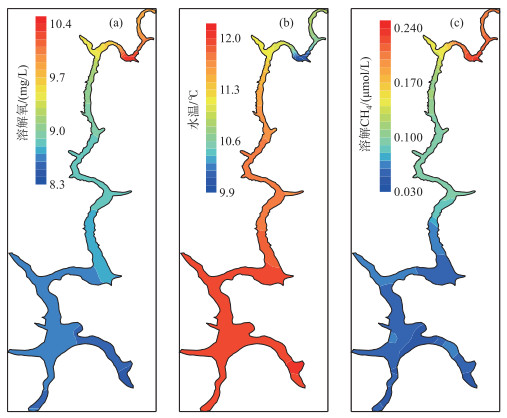(2: 三峡库区生态环境教育部工程中心, 宜昌 443002)
(2: Engineering Research Center of Eco-environment in Three Gorges Reservoir Region, Yichang 443002, P. R. China)
水库在全球甲烷(CH4)产生和排放中起着至关重要的作用. 全球范围内,水库每年向大气排放51 Tg的碳,其中36.8 Tg以二氧化碳的形式排放,13.3 Tg以CH4的形式排放[1]. 水库中CH4排放到大气中的途径主要有3种:沉积物中释放的气泡、水体中溶解的CH4通过空气-水界面的扩散以及挺水植物的茎秆[2],其中大约40 % 是通过水-气界面的分子扩散排放到大气中[1],尤其是深水湖库中CH4释放以扩散为主[3-4]. 近年来,很多学者在水库中开展了定点24 h连续观测或选取代表性点位监测特定时段内的扩散通量[5-6],但这些监测数据可能并不能准确代表整个水库,因为CH4扩散通量受当地水文气象条件的变化和溶解CH4浓度分布不均等诸多因素的影响,因此在时间和空间上有较大差异. 事实上,同一湖库不同区域的溶解CH4浓度差异很大,单个湖库一般存在水平和垂直的浓度梯度:一方面,沿岸沉积物可能成为表层水体溶解CH4的“源”,存在近岸带与开阔水域的平流输送[7-8],支流中高浓度溶解CH4对开阔区水体的贡献[9],雨季陆源有机质的输入导致沿岸水体中溶解CH4浓度升高[10];另一方面,沉积物持续向水体中扩散CH4,通常最接近沉积物的水层溶解浓度最高并累积在温跃层以下[11-12],在部分湖库中也发现溶解CH4浓度峰值出现在温跃层之上的情况[13-14],原因可能是季节变化引起的水体掺混,能够使温跃层以下的溶解CH4向水面迁移[1]. 因此,研究水体中溶解CH4浓度的空间分布规律不仅是准确估算其排放通量的关键,也是揭示湖库中CH4形成机制的重要支撑.
以往对水体溶存CH4浓度的监测通常使用顶空平衡等方法[15-16],实验过程相对耗时耗力,导致一定时间内有限样点、有限次数的监测,且数据精度受实验者主观操作技能的影响较大. Xiao等新近研制的新型快速水-气平衡装置(FaRAGE)[17]极大缩短了响应时间(t95 % =12 s,包括温室气体分析仪的响应时间),且达到了误差小于0.5 % 的测量精度,连接便携式温室气体分析仪能够实现水中溶解CH4浓度的高频连续监测. 本文利用该装置以宜昌市黄柏河流域内的西北口水库为例,走航式原位监测水体溶解CH4浓度及水环境因子,初步探讨河道型水库溶解CH4浓度的分布规律和重要影响因子,以期为同类型水库CH4排放的准确估计及水库温室气体模型的开发提供科学参考.
1 材料与方法 1.1 研究区概况西北口水库位于湖北省宜昌市夷陵区境内,系长江北岸一级支流黄柏河流域梯级开发的骨干工程,大坝类型为钢筋砼面板堆石坝,最大坝高95 m,水库总库容2.1亿m3,为大(2)型水库,坝址以上承雨面积862 km2,多年平均径流量3.88亿m3①.
① 数据来源于宜昌市水利局.
本次实验过程中,从库首至库尾选取了3个采样点开展垂向监测(图 1),分别代表水库中不同水深的区域.

|
图 1 西北口水库监测点分布 Fig.1 Distribution of the sampling sites in the Xibeikou Reservoir |
走航式监测时将多参数水质仪(HydrolabDS5,美国)固定在船的一侧(水面以下20 cm),船在航行过程中连续测定水温、溶解氧浓度、pH、水深、叶绿素a浓度等水体理化因子;定点垂向监测时将多参与潜水泵固定在一起用绳子从表层缓慢放到底层连续监测.
1.2.2 水体溶解CH4浓度监测包括表层水体连续走航式监测和典型断面垂向监测,水中溶解CH4浓度采用新型快速水-气平衡装置及方法[17]连接便携式温室气体分析仪(Picarro G2201-i)连续测定. 当进行走航式监测时,将水-气平衡装置的进水口连接到水面以下20 cm处的潜水泵,从库首开始向库尾方向走“S”形航线连续取水,与此同时使用移动设备上的GPS软件记录船只移动过程的地理坐标与时间. 断面溶解CH4浓度的剖面监测与多参数水质仪分层监测同步,整个实验过程中均未扰动沉积物.
1.3 水-气界面气体扩散通量估算方法采用薄边界层法[18]计算水库内水-气界面CH4扩散通量,其中表层浓度通过原位连续走航式监测,风速数据由黄柏河下游夷陵区气象站提供.
1.4 数据分析和绘图方法采用Spearman相关系数分析表层溶解CH4浓度与水体各理化因子的相关性. 基于走航过程中连续监测的溶解CH4浓度值和水环境因子,以及移动设备记录船只航行过程的经纬度值绘制表层水体溶解CH4浓度和环境因子空间分布图.
2 结果与分析 2.1 表层水体环境因子与溶解CH4浓度的分布特征表层水体pH均值为8.2(7.3~9.2),水库水体呈弱碱性;电导率均值为475 μS/cm (470~485 μS/cm),浊度均值为47.2 NTU(43.0~65.2 NTU),叶绿素a浓度均值为2.83 μg/L(0.88~11.69 μg/L),溶解氧浓度均值为8.81 mg/L(8.37~10.38 mg/L)(图 2a),水温范围在9.85~12.03℃,坝前开阔水域的水温变化不大,库中至库尾水温逐渐降低(图 2b). 表层水体溶解CH4浓度平均值为0.079 μmol/L,从库尾至库首方向逐渐减小,最大值(0.233 μmol/L)出现在库尾,最低值(0.039 μmol/L)在库首(图 2c). 按深泓线每1 km为间距把水库分为13段,然后计算相邻段表层水体溶解CH4平均浓度的变化率,在距回水末端1和7 km处识别出两个浓度变化的突变点,据此将表层溶解CH4浓度的变化分为3个部分:距回水末端1 km内为浓度快速降低段,浓度范围为0.117~0.233 μmol/L,水深为0.72~5.63 m;1~6 km内为缓慢降低段,浓度范围为0.055~0.117 μmol/L,水深为5.63~24.77 m;6~13 km范围内为浓度平稳段,浓度范围为0.039~0.080 μmol/L,水深为24.77~27.66 m.

|
图 2 西北口水库表层水体溶解氧浓度(a)、水温(b)和溶解CH4浓度(c) Fig.2 Dissolved oxygen concentration (a), water temperature (b) and dissolved CH4 (c) in surface water of the Xibeikou Reservoir |
1#采样点从水面到24.5 m水温均值为(12.04±0.01)℃,24.5 m到底层水温从12.02℃逐渐减小到11.70℃;溶解氧分布与水温变化相似,从表层至24.5 m均值为(8.32±0.02) mg/L,从24.5 m至底层从8.35 mg/L逐渐减小到8.16 mg/L;电导率从表层至24.5 m变化不大,均值为481 μS/cm,从24.5 m至底层逐渐增大到488 μS/cm;浊度从表层74.0 NTU逐渐下降至底层73.0 NTU,溶解氧和叶绿素a浓度在水柱上变化不大,均值分别为8.31 mg/L和1.28 μg/L(图 3). 2#采样点从水面到22.3 m水温均值为(11.96±0.01)℃,22 m到底层水温从11.95℃逐渐减小到11.41℃;溶解氧浓度从表层至22.3 m均值为(8.65±0.03) mg/L,从22.3 m至底层逐渐增加到8.93 mg/L;电导率从表层至24 m变化不大,均值为476 μS/cm,从24 m至底层逐渐增大到488 μS/cm;浊度从表层的62.5 NTU逐渐下降至底层的60.3 NTU,溶解氧和叶绿素a浓度在水柱上变化不大,均值分别为8.66 mg/L和1.92 μg/L(图 4). 3#采样点水深仅4.76 m,垂向水体基本混匀,水温、pH、电导率、溶解氧浓度和叶绿素a浓度均值分别为(11.51±0.01)℃、8.18±0.01、473 μS/cm、(9.09±0.03) mg/L和3.89 μg/L,浊度从表层的58.0 NTU缓慢下降到底层的56.5 NTU(图 5).

|
图 3 西北口水库1#采样点溶解CH4浓度及环境因子垂向分布 Fig.3 Vertical distributions of dissolved CH4 concentration and environmental factors at sampling site 1# in the Xibeikou Reservoir |

|
图 4 西北口水库2#采样点溶解CH4浓度及环境因子垂向分布 Fig.4 Vertical distributions of dissolved CH4 concentration and environmental factors at sampling site 2# in the Xibeikou Reservoir |

|
图 5 西北口水库3#采样点溶解CH4浓度及环境因子垂向分布 Fig.5 Vertical distributions of dissolved CH4 concentration and environmental factors at sampling site 3# in the Xibeikou Reservoir |
1#采样点溶解CH4浓度从表层的0.035 μmol/L升高至底层的0.038 μmol/L,均值为(0.036±0.001) μmol/L,在12~17 m水深范围浓度有较小波动. 2#采样点溶解CH4浓度从表层的0.048 μmol/L升高到底层的0.053 μmol/L,均值为(0.049±0.001) μmol/L,1#和2#采样点垂向CH4浓度在中上层变化均不明显,而在底层逐渐升高,在库底达到最大. 3#采样点垂向溶解CH4浓度均值为(0.200±0.003) μmol/L,与1#、2#采样点不同的是,从表层至水面下4 m处溶解CH4浓度从0.201 μmol/L缓慢升高到0.209 μmol/L,然后至库底缓慢降到0.203 μmol/L.
3 讨论 3.1 水库溶解CH4浓度变化规律及主要影响因素表层水体溶解CH4浓度与距回水末端的距离呈显著负相关关系(r=-0.81,P < 0.01,表 1),观测的西北口水库上游天然河道的溶解CH4浓度为0.020 μmol/L,仅为库尾最高浓度的十分之一,说明库尾水体中溶存CH4以沉积物扩散为主. 库尾常设有拦污网,天然河流汇入水库后,大量来自上游的污染物被拦截累积在库尾,刘佳等[19]在该水库的监测结果显示沉积物中总磷含量从库尾至库首呈现递减趋势. 此外,作者在全年监测中发现库尾浅水区水体的叶绿素a浓度均高于中下游的区域,其中秋季库尾表层叶绿素a浓度高达32 μg/L,3#采样点的底层溶解CH4浓度的高值很可能是由于多年来不断沉积的藻类残体成为被CH4菌还原的底物,增加了沉积物的CH4产量[20-21]. 事实上,河流入库口及水体营养状况已被指出是影响湖库溶解CH4分布的一个关键因素,例如Borges等对Kivu湖的巡航观测发现在同一湖泊中,小支流的溶解CH4浓度总比湖中心高[22],Paranaíba等采用膜渗透方法对3个水库的走航监测发现每个水库的河流流入区溶解CH4浓度均较高[16],所以表层CH4浓度梯度很可能是浅水区较高浓度的溶存CH4沿河道向下游水体的水平扩散. 这种沿表层水体水平输送而产生的空间差异在其他湖库研究中也有报道,例如Pighini等监测大小不同湖库后发现,不同湖泊中岸边水体溶解CH4总比湖中心高很多,通过同位素分析发现开阔水体的溶解CH4很多来自于浅水区沉积物[23],Fernández等发现同一湖泊中表层水体溶解CH4的平均浓度和浅水区表面积/湖泊总面积呈显著正相关关系,但与整个湖泊面积的相关性并不显著[24].
| 表 1 西北口水库表层溶解CH4浓度、溶解氧与水体理化参数的相关性分析(N=1050) Tab. 1 Correlation analysis of dissolved CH4 concentration, dissolved oxygen with physical and chemical parameters of surface water in the Xibeikou Reservoir (N=1050) |
以浓度变化为依据将水库划分为3个部分,其中浓度快速降低段(水深 < 5.63 m)的平均浓度是整个水库平均浓度的2.16倍,但是其河道长度仅占整个水库的2/13. 水深作为沉积物与表层水体连通性的表征,是衡量CH4原位产生及消耗的重要指标[25]. 淡水湖泊中51 % ~80 % 的溶解CH4被氧化消耗[26],溶解CH4浓度、溶解氧浓度及水温等因素均会影响微生物在水体中的氧化效率. 本次调查中,表层溶解CH4浓度与水深呈显著负相关关系(r=-0.89,P < 0.01,表 1).气泡扩散是水库CH4释放的常见方式,这些气泡内几乎可以全部是CH4,也可以是CH4、氮气、二氧化碳和氢气的混合气体. 3个采样点底部溶解CH4浓度为1# < 2# < 3#,说明较高的静水压力(即水深)可能会减少沉积物的CH4气泡的释放量[27],从而降低气泡在上升的过程中与周围水体的交换[28],库尾浅水区域较小的静水压力和受到风浪和船只的扰动更容易产生气泡[29-30],这些气泡在水柱中上升的过程中迅速和周围水体进行气体交换而增加水体溶解CH4的量. 另一方面,比较3个断面上溶解CH4浓度的变化过程,库首和库中底层溶解CH4浓度均在沉积物以上约4~5 m范围内呈线性减少,在中上层变化不大;水深越深,溶存CH4在水柱中扩散的过程中消耗量越高[31],库尾浅水区垂向水体掺混,底层溶解CH4通过水体对流更易交换到表层.
表层溶解CH4浓度与叶绿素a浓度之间呈显著正相关关系(r=0.95,P < 0.01,表 1). 藻类新陈代谢过程中除了对沉积物有机质的贡献之外[32],部分学者认为富营养化水体中蓝藻易将无机碳转化为CH4,并通过甲基磷酸盐的去甲基化产CH4[33]. 但是在国内其他富营养化淡水水域的调查结果中溶解CH4浓度与本次冬季实验的结果很相近(表 2),并且在国内其他水库的调查还发现了表层水体溶解CH4浓度与叶绿素a浓度的负相关关系[34]. 不同水体中,溶解CH4浓度受众多水环境因素的共同影响,叶绿素a浓度是否是水体溶解CH4浓度的主要控制因素还需进一步研究. 叶绿素a浓度能较好地表征淡水生态系统中浮游植物的数量和分布特征,浮游植物光合作用产生氧气,其死亡后又能成为沉积物中发酵产生CH4的原料,所以表层溶解CH4浓度与溶解氧浓度呈显著正相关关系(r=0.97,P < 0.01,表 1).
| 表 2 国内外部分淡水生态系统溶解CH4浓度对比 Tab. 2 Comparison of dissolved CH4 concentrations in some freshwater ecosystems at home and abroad |
水库水温的高低及分布是由季节变化及其他自然因素共同影响的结果,水温直接影响气体溶解度及水柱上的对流模式,水库在各个季节呈现完全不同的温度分布,从而影响垂向水体的掺混程度及物质的迁移转化. 本次调查中库尾表层水温最低值比库首低2.18℃,3#采样点底层水温比1#采样点底层水温低2.53℃. 表层水体溶解CH4浓度与表层水温呈显著负相关(r=-0.77,P < 0.01,表 1),与以往湖泊和稻田的研究结论并不一致[35-36]. 天然湖泊与河道型水库的区别在于湖泊边界较为固定,边缘受日照影响大,浅水区水温比湖中深水区高;而山区河道型水库的水温分布不同,尤其是在冬季枯水期,支流基本枯竭,受上游来流和两岸山体遮掩的影响,表层水温表现出沿河道的纵向差异. 不少学者发现溶解CH4浓度与水温呈正相关关系是因为水温升高有利于增大沉积物的CH4产量[37]. 但本次实验过程中我们发现,1#采样点底层水温高于3#采样点底层水温,而溶解CH4浓度的大小却相反,可能是因为在冬季水温较低的情况下,沉积物中产CH4菌对温度的敏感性并不大. pH值与水体有机质、微生物的分解和水生生物的代谢密切相关,是影响CH4产生和释放的重要因素之一,但是本次实验中,表层水体溶解CH4浓度与pH值相关性较小,在冬季可能是影响其分布的次要因素.
选取水深(h)或距回水末端的距离(L)作为影响水库表层溶解CH4浓度(CCH4)分布的主要因子(0.17 m≤ h≤27.66 m,L < 12.9 km),采用幂函数和对数函数进行拟合,结果如表 3所示. 从拟合结果可以看出,以水深或距回水末端的距离为自变量的幂函数和对数函数关系式均能较好地呈现西北口水库表层水体溶解CH4浓度的沿程分布规律.
| 表 3 西北口水库不同形式的表层溶解CH4浓度拟合关系式 Tab. 3 Different forms of fitting functions for surface dissolved CH4 in the Xibeikou Reservoir |
以表层水体溶解CH4浓度变化的空间分区为依据,利用薄边界层法在监测地区当月平均风速(1.4 m/s)下估算3个区域内水-气界面的CH4扩散通量:浓度快速降低段的通量平均值为(0.023±0.004) mg/(m2 ·h),缓慢降低段和浓度平稳段的通量平均值分别为(0.012±0.003)和(0.007±0.001) mg/(m2 ·h). 浓度快速降低段的扩散通量分别是缓慢降低段和浓度平稳段通量的1.92和3.29倍,但其河道长度仅占整个水库的2/13,这意味着以往仅在开阔水域内单一点位测量的通量数据,其研究结果可能低估了水库的扩散通量. Li等[39]发现单位面积的水库CH4排放量在非生物因素中与气温、水温的相关性最为显著,本次调查的水库在冬季的扩散通量相较于国内其他水库的调查结果处于较低水平(表 4),可能是由于冬季沉积物中产CH4菌的代谢活性较低,并且枯水期水库中水体停留时间相对较长,大量溶解CH4被氧化消耗,所以水-气界面的扩散通量相对较低.
| 表 4 国内部分水库水-气界面CH4扩散通量对比 Tab. 4 Comparison of CH4 diffusive fluxes at the air-water interface from some reservoirs in China |
为了探讨河道型水库溶解甲烷浓度的空间分布规律,利用新型快速水-气平衡装置(FaRAGE)连接便携式温室气体分析仪对西北口水库进行走航式监测及垂向监测,主要结论如下:
1) 表层水体溶解CH4浓度呈现出从库尾至库首逐渐降低的分布特征:距回水末端1 km内为浓度快速降低段,溶解CH4浓度范围为0.117~0.233 μmol/L;1~6 km内为缓慢降低段,溶解CH4浓度范围为0.055~0.117 μmol/L;6~13 km范围内为浓度平稳段,溶解CH4浓度范围为0.039~0.080 μmol/L.
2) 水库表层水体溶解CH4浓度与表层水温、水深及距回水末端的距离呈显著负相关关系(r=-0.77、-0.89、-0.81;P < 0.01),与叶绿素a浓度、溶解氧浓度呈显著正相关关系(r=0.95、0.97;P < 0.01). 以水深或距回水末端的距离为自变量给出的对数拟合和幂函数拟合公式能较好地表达西北口水库表层溶解CH4浓度的分布规律.
3) 当月平均风速下,浓度快速降低段的甲烷扩散通量分别是缓慢降低段和浓度平稳段的1.92和3.29倍,其河道长度仅占整个水库的2/13,说明库尾浅水区域是甲烷释放的“热点”区域.
| [1] |
Deemer BR, Harrison JA, Li SY et al. Greenhouse gas emissions from reservoir water surfaces: A new global synthesis. BioScience, 2016, 66(11): 949-964. DOI:10.1093/biosci/biw117 |
| [2] |
Bastviken D, Cole J, Pace M et al. Methane emissions from lakes: Dependence of lake characteristics, two regional assessments, and a global estimate. Global Biogeochemical Cycles, 2004, 18(4). DOI:10.1029/2004gb002238 |
| [3] |
West WE, Creamer KP, Jones SE. Productivity and depth regulate lake contributions to atmospheric methane. Limnology and Oceanography, 2016, 61(S1): S51-S61. DOI:10.1002/lno.10247 |
| [4] |
Li MX, Peng CH, Zhu QA et al. The significant contribution of lake depth in regulating global lake diffusive methane emissions. Water Research, 2020, 172: 115465. DOI:10.1016/j.watres.2020.115465 |
| [5] |
Chen M, Xu HT, Wang XZ et al. Impact of rainfall-runoff events on methane emission from Xiangxi bay of the Three Gorges Reservoir. Environmental Science, 2021, 42(2): 732-739. [陈敏, 许浩霆, 王雪竹等. 降雨径流事件对三峡水库香溪河库湾甲烷释放的影响. 环境科学, 2021, 42(2): 732-739. DOI:10.13227/j.hjkx.202007063] |
| [6] |
Qin Y, Wang ZW, Li Z et al. CO2 and CH4 flux across water-air interface and environmental factors in Pengxi River of the Three Gorges Reservoir. Journal of Earth Environment, 2019, 10(2): 177-189. [秦宇, 王紫薇, 李哲等. 三峡水库澎溪河水-气界面CO2与CH4通量特征及影响因素初探. 地球环境学报, 2019, 10(2): 177-189. DOI:10.7515/JEE182071] |
| [7] |
Hofmann H. Spatiotemporal distribution patterns of dissolved methane in lakes: How accurate are the current estimations of the diffusive flux path?. Geophysical Research Letters, 2013, 40(11): 2779-2784. DOI:10.1002/grl.50453 |
| [8] |
Peeters F, Fernandez JE, Hofmann H. Sediment fluxes rather than oxic methanogenesis explain diffusive CH4 emissions from lakes and reservoirs. Scientific Reports, 2019, 9: 243. DOI:10.1038/s41598-018-36530-w |
| [9] |
Murase J, Sakai YJ, Sugimoto A et al. Sources of dissolved methane in Lake Biwa. Limnology, 2003, 4(2): 91-99. DOI:10.1007/s10201-003-0095-0 |
| [10] |
Zhou Y, Xiao Q, Yao X et al. Accumulation of terrestrial dissolved organic matter potentially enhances dissolved methane levels in eutrophic Lake Taihu, China. Environmental Science & Technology, 2018, 52(18): 10297-10306. DOI:10.1021/acs.est.8b02163 |
| [11] |
Li B, Gu QJ, Miao YQ et al. Methane distribution patterns along a transect of Lake Fuxian, a deep oligotrophic lake in China. Environmental Science and Pollution Research, 2020, 27(21): 25848-25860. DOI:10.1007/s11356-019-06098-7 |
| [12] |
Juutinen S, Rantakari M, Kortelainen P et al. Methane dynamics in different boreal lake types. Biogeosciences, 2009, 6(2): 209-223. DOI:10.5194/bg-6-209-2009 |
| [13] |
Grossart HP, Frindte K, Dziallas C et al. Microbial methane production in oxygenated water column of an oligotrophic lake. PNAS, 2011, 108(49): 19657-19661. DOI:10.1073/pnas.1110716108 |
| [14] |
Donis D, Flury S, Stöckli A et al. Full-scale evaluation of methane production under oxic conditions in a mesotrophic lake. Nature Communications, 2017, 8: 1661. DOI:10.1038/s41467-017-01648-4 |
| [15] |
Zhang JW, Lei D, Xiao SB et al. Partial pressure of carbon dioxide and methane from autumn to winter in Xiangxi Bay of the Three Gorges Reservoir. Environmental Science, 2016, 37(8): 2924-2931. [张军伟, 雷丹, 肖尚斌等. 三峡库区香溪河秋末至中冬CO2和CH4分压特征分析. 环境科学, 2016, 37(8): 2924-2931. DOI:10.13227/j.hjkx.2016.08.013] |
| [16] |
Paranaíba JR, Barros N, Mendona R et al. Spatially resolved measurements of CO2 and CH4 concentration and gas-exchange velocity highly influence carbon-emission estimates of reservoirs. Environmental Science & Technology, 2018, 52(2): 607-615. DOI:10.1021/acs.est.7b05138 |
| [17] |
Xiao SB, Liu L, Wang W et al. A fast-response automated gas equilibrator (FaRAGE) for continuous in situ measurement of CH4 and CO2 dissolved in water. Hydrology and Earth System Sciences, 2020, 24(7): 3871-3880. DOI:10.5194/hess-24-3871-2020 |
| [18] |
Matthews CJD, St Louis VL, Hesslein RH. Comparison of three techniques used to measure diffusive gas exchange from sheltered aquatic surfaces. Environmental Science & Technology, 2003, 37(4): 772-780. DOI:10.1021/es0205838 |
| [19] |
Liu J, Lei D, Li Q et al. Characteristics of phosphorus fractions and phosphate diffusion fluxes of sediments in cascade reservoirs of the Huangbai River. Environmental Science, 2018, 39(4): 1608-1615. [刘佳, 雷丹, 李琼等. 黄柏河流域梯级水库沉积物磷形态特征及磷释放通量分析. 环境科学, 2018, 39(4): 1608-1615. DOI:10.13227/j.hjkx.201705112] |
| [20] |
West WE, Coloso JJ, Jones SE. Effects of algal and terrestrial carbon on methane production rates and methanogen community structure in a temperate lake sediment. Freshwater Biology, 2012, 57(5): 949-955. DOI:10.1111/j.1365-2427.2012.02755.x |
| [21] |
Loken LC, Crawford JT, Schramm PJ et al. Large spatial and temporal variability of carbon dioxide and methane in a eutrophic lake. Journal of Geophysical Research: Biogeosciences, 2019, 124(7): 2248-2266. DOI:10.1029/2019jg005186 |
| [22] |
Borges AV, Abril G, Delille B et al. Diffusive methane emissions to the atmosphere from Lake Kivu (Eastern Africa). Journal of Geophysical Research: Biogeosciences, 2011, 116(G3): G03032. DOI:10.1029/2011jg001673 |
| [23] |
Pighini S, Ventura M, Miglietta F et al. Dissolved greenhouse gas concentrations in 40 lakes in the Alpine area. Aquatic Sciences, 2018, 80(3): 1-13. DOI:10.1007/s00027-018-0583-2 |
| [24] |
Encinas Fernández J, Peeters F, Hofmann H. On the methane paradox: Transport from shallow water zones rather thanin situ methanogenesis is the major source of CH4 in the open surface water of lakes. Journal of Geophysical Research: Biogeosciences, 2016, 121(10): 2717-2726. DOI:10.1002/2016JG003586 |
| [25] |
Lima IBT. Biogeochemical distinction of methane releases from two Amazon hydroreservoirs. Chemosphere, 2005, 59(11): 1697-1702. DOI:10.1016/j.chemosphere.2004.12.011 |
| [26] |
Bastviken D, Cole JJ, Pace ML et al. Fates of methane from different lake habitats: Connecting whole-lake budgets and CH4 emissions. Journal of Geophysical Research: Biogeosciences, 2008, 113(G2). DOI:10.1029/2007jg000608 |
| [27] |
Wik M, Crill PM, Varner RK et al. Multiyear measurements of ebullitive methane flux from three subarctic lakes. Journal of Geophysical Research: Biogeosciences, 2013, 118(3): 1307-1321. DOI:10.1002/jgrg.20103 |
| [28] |
McGinnis DF, Greinert J, Artemov Y et al. Fate of rising methane bubbles in stratified waters: How much methane reaches the atmosphere?. Journal of Geophysical Research: Oceans, 2006, 111(C9): C09007. DOI:10.1029/2005jc003183 |
| [29] |
Hofmann H, Federwisch L, Lorke A et al. Wave-induced release of methane in lake littoral zones, 2009.
|
| [30] |
DelSontro T, Kunz MJ, Kempter T et al. Spatial heterogeneity of methane ebullition in a large tropical reservoir. Environmental Science & Technology, 2011, 45(23): 9866-9873. DOI:10.1021/es2005545 |
| [31] |
Lei D, Liu J, Zhang JW et al. Methane oxidation in the water column of Xiangxi Bay, Three Gorges Reservoir. CLEAN - Soil, Air, Water, 2019, 47(9): 1800516. DOI:10.1002/clen.201800516 |
| [32] |
Yan XC, Zhang ZQ, Ji M et al. Concentration of dissolved greenhouse gas and its influence factors in the summer surface water of eutrophic lake. J Lake Sci, 2018, 30(5): 1420-1428. [闫兴成, 张重乾, 季铭等. 富营养化湖泊夏季表层水体温室气体浓度及其影响因素. 湖泊科学, 2018, 30(5): 1420-1428. DOI:10.18307/2018.0523] |
| [33] |
Mina Bižić M, Klintzsch T, Ionescu D et al. Aquatic and terrestrial cyanobacteria produce methane. Science Advances, 2020, 6(3): 5343. DOI:10.1126/sciadv.aax5343 |
| [34] |
Chen GW. Spatio-temporal distribution patterns of dissolved methane and the influencing factors in the Gutian Reservior Fujian Province, China [Dissertation]. Nanchang: Jiangxi Normal University, 2020. [陈功伟. 福建省古田水库水体溶解性甲烷时空分异特征及其影响因素研究[学位论文]. 南昌: 江西师范大学, 2020. ]
|
| [35] |
Schütz H, Seiler W, Conrad R. Processes involved in formation and emission of methane in rice paddies. Biogeochemistry, 1989, 7(1): 33-53. DOI:10.1007/BF00000896 |
| [36] |
Rasilo T, Prairie YT, del Giorgio PA. Large-scale patterns in summer diffusive CH4 fluxes across boreal lakes, and contribution to diffusive C emissions. Global Change Biology, 2015, 21(3): 1124-1139. DOI:10.1111/gcb.12741 |
| [37] |
Dunfield P, Knowles R, Dumont R et al. Methane production and consumption in temperate and subarctic peat soils: Response to temperature and pH. Soil Biology and Biochemistry, 1993, 25(3): 321-326. DOI:10.1016/0038-0717(93)90130-4 |
| [38] |
Yang L, Lu F, Wang XK et al. Spatial and seasonal variability of diffusive methane emissions from the Three Gorges Reservoir. Journal of Geophysical Research: Biogeosciences, 2013, 118(2): 471-481. DOI:10.1002/jgrg.20049 |
| [39] |
Li G, Li HL, Yang M et al. Seasonal and diurnal methane and carbon dioxide emissions from the littoral area of the Miyun Reservoir in Beijing, China. Marine and Freshwater Research, 2018, 69(5): 751. DOI:10.1071/mf17114 |
| [40] |
Yang M, Li HL, Lei T et al. Spatial-temporal characteristics of methane emission flux and its influence factors at Miyun Reservoir in Beijing. Wetland Science, 2011, 9(2): 191-197. [杨萌, 李红丽, 雷霆等. 北京密云水库甲烷排放通量时空特征及其影响因素研究. 湿地科学, 2011, 9(2): 191-197.] |
| [41] |
Xiao SB, Wang YC, Liu DF et al. Diel and seasonal variation of methane and carbon dioxide fluxes at Site Guojiaba, the Three Gorges Reservoir. Journal of Environmental Sciences, 2013, 25(10): 2065-2071. DOI:10.1016/S1001-0742(12)60269-1 |
| [42] |
Gong WQ, Wen SL, Wang HW et al. Characteristics of greenhouse gas occurrence and emission in summer and autumn of Daheiting Reservoir. China Environmental Science, 2019, 39(11): 4611-4619. [龚琬晴, 文帅龙, 王洪伟等. 大黑汀水库夏秋季节温室气体赋存及排放特征. 中国环境科学, 2019, 39(11): 4611-4619. DOI:10.3969/j.issn.1000-6923.2019.11.016] |
| [43] |
Zheng H, Zhao XJ, Zhao TQ et al. Spatial-temporal variations of methane emissions from the Ertan hydroelectric reservoir in southwest China. Hydrological Processes, 2011, 25(9): 1391-1396. DOI:10.1002/hyp.7903 |
| [44] |
Li JH, Pu JB, Sun PA et al. Summer greenhouse gases exchange flux across water-air interface in three water reservoirs located in different geologic setting in Guangxi, China. Environmental Science, 2015, 36(11): 4032-4042. [李建鸿, 蒲俊兵, 孙平安等. 不同地质背景水库区夏季水-气界面温室气体交换通量研究. 环境科学, 2015, 36(11): 4032-4042. DOI:10.13227/j.hjkx.2015.11.012] |
 2021, Vol. 33
2021, Vol. 33 

